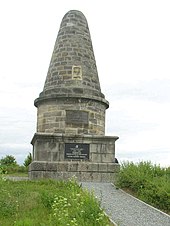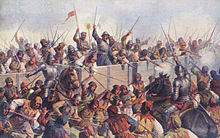Battle of Lipan
The Battle of Lipan was a decisive military encounter that had a decisive influence on the outcome of the Hussite Wars . In German historical sources the dispute is also referred to as the Battle of Böhmisch Brod .
On Sunday, May 30, 1434, south of the village of Lipany, the united troops of the radical Hussites ( Taborites ) under the leadership of Prokop the Great and the soldiers of the orphans , led by Jan Čapek ze Sán , and on the other side the Coalition of moderate Utraquists and Catholics . The moderates were outnumbered, while the radicals had experienced fighters who had been coordinated through many struggles.
Both armies used classic Hussite combat tactics and equipment . Both sides were also led by experienced commanders. The tandem Prokop Holý and Jan Čapek ze Sán faced the no less experienced goblet brother Diviš Bořek z Miletínka , an old fighter of Jan Žižka .
The battle started tough. The radicals that arrived first took a favorable position. This was located on hills southwest of Lipan and was enclosed in a six-row wagon castle . With enough food they waited for the enemy to arrive. They relied on their nervousness to grow over time, as their territory was unprotected. They expected a collapse of the coalition and weakening of the Catholics or their general attack under unfavorable conditions. The moderates' commanders understood this situation and tried to resolve the situation with a ruse.
Diviš Bořek z Miletínka hid his riders in a valley near the wagon castle and approached the enemy with his own wagon castle. The shelling began after 3 p.m. The coalition soldiers feigned confusion, the wagon castle fell apart, and a disorderly retreat began.

At the time the withdrawal began, the two commanders of the orphans made a serious mistake. At the sight of the fleeing soldiers, they saw another easy victory, as in the previous easily won battles, ahead of them. They opened the wagon castle so that this time too they could put the disorganized and demoralized army to flight with their “god-given riders”. The moderates waited until Jan Čapek ze Sán was far enough away from the fortress and everyone was watching the approaching massacre to attack with the hidden cavalry .
The cavalry group attacked the open wagon castle, captured it and held it until the infantry hurried to the rescue . This was now completely distributed, but suddenly showed a completely offensive behavior. The change aroused the suspicion of the orphans too late, who by then saw hard fighting and the approaching opposing army in the open field. They realized that they would not be able to close the wagon castle in time.
Jan Čapek ze Sán heard the desperate signals of his fellow combatant Prokop Holý, who had remained in the wagon castle with his infantry. Jan realized that he would not be able to retake the wagon castle and that one of the principles of the Hussite fighting tactics never failed: if the wagon castle falls, the battle is lost . The infantry could no longer be helped. Jan Čapek ze Sán withdrew with the cavalry to the nearby impregnable city of Kolín and thus saved at least part of his army.
The battle ended in a massacre, with the victors liquidating most of the prisoners (around nine hundred alone were burned in barns) and thus wiping out the core of the Taborites. Some of the prisoners of the Taborite army, originally numbering 12,000, sided with the moderates, originally around 20,000 men, some of the survivors enlisted as mercenaries in foreign armies, and a small fraction offered resistance for a while, including to Example Jan Roháč z Dubé . However, this rather symbolic resistance did not last long. Roháč was finally defeated on September 9, 1437 at Kuttenberg . After refusing to recognize Sigismund as king, he was hanged in Prague . The Hussite Wars in Bohemia were over.
In 1881 a burial mound was built on the Lipan hill.
literature
- Jan Durdik: Hussite army . Translated into German by Eberhard Wolfgram. Berlin: German military publisher 1961.
- Jiří Kejř; Jiří Ployhar (photos): The Hussite Revolution . Translated from the Czech by Dagmar Bilková. Orbis, Prague 1988, DNB 891488057 .
- Lutz Mohr : The Hussites in Upper Lusatia with special consideration of their campaigns in the years from 1424 to 1434 . Special edition No. 2/2014 of the series: History and stories from Neusalza-Spremberg. Greifswald u. Neusalza-Spremberg 2014.
Web links
- Battles of the Hussites at a glance , English
Coordinates: 50 ° 1 ′ 43 ″ N , 14 ° 56 ′ 13 ″ E

